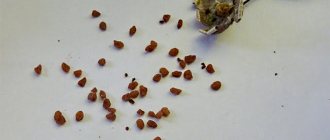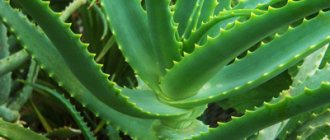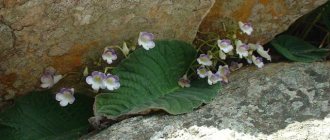Cyclamen persica
Persian cyclamen (Cyclamen persicum) comes from the Mediterranean and northern Africa with hot summers and cool winters. The plant has adapted to such conditions in its own way, grows and blooms in comfortable weather from autumn to spring (there are varieties that bloom in autumn and bloom in winter), and rests in the summer, completely shedding its leaves. In order not to die, cyclamen stores nutrients in a special organ - the tuber (the tuber is the thickened part of the stem under the cotyledon leaves - the hypocotyl).
The undoubted advantage of Persian cyclamen is that it blooms in winter, when there are not many flowering plants. More often it is used once, similar to a bouquet, since Persian cyclamen is an ephemeral plant. Its life cycle is divided into two distinct periods: rest, which lasts up to 9 months, and growth and flowering, which continues the rest of the year. But you can try to save it until the next flowering, which will delight you next winter.
The Dutch company Schoneveld offers the following F1 hybrids of Persian cyclamen: • Super Serie Micro F1 - characterized by a large number of miniature and very long-blooming flowers. There are 17 colors. • Super Serie Verano F1 - in terms of flower size, it belongs to the mini-cyclamen section, designed for growing in warm conditions. 16 colors. • Super Series Compact F1 - characterized by very abundant flowering and long flower life, compact in growth form. 21 colors. • Super Series Da Vinci (Super Serie Da Vinci F1) - has all the qualities of cyclamen Super Series Compact, has silver leaves. 9 colors. • Super Series Mini Winter F1 - specially designed for flowering at the end of the season in the climate of northern Europe, has looser leaves, which ensures better air circulation between the leaves, flowers are not large. 15 colors. • Super Series Picasso (Super Serie Picasso F1) - this series is derived from the Super Series Mini Winter, differs from it in silver leaves. 9 colors. • Super Series Original F1 - medium-sized flowers on a large plant, characterized by very abundant flowering, there are 16 colors, including uneven colors. • Super Serie Allure F1 - medium-sized flowers, the series is specially bred for warm growing, characterized by earlier flowering. 14 colors. • Super Serie Macro F1 - medium flower size on a large plant, characterized by a huge number of flowers with long flowering. 18 colors. • Super Series XL (Super Serie XL F1) - large flowers on large plants, long flowering. 16 colors. • Super Series Michelangelo (Super Serie Michelangelo F1) - mini cyclamen with unique marble leaves, combines the best qualities of the Super Series Compact and Super Series Mini Winter. 9 colors. • Super Series Jive F1 - has elegant wavy petals. 8 bright colors of flowers. • Super Series Mammoth F1 - has beautiful large flowers on a large plant. 8 colors.
Five lines of F1 hybrids offered by the French company Morel:
- Metis® – miniature, hardy and early flowering, with the widest range of shades;
- Tianis® - “midi”, with medium-sized flowers, a very compact habit and a very early onset of flowering;
- Latinia Premium (Latinia® Premium) – with medium-sized flowers, compact habit and early onset of flowering;
- Latinia® - with very large flowers, compact habit and early onset of flowering;
- Halios® – with large flowers, traditional qualities.
There are varieties of another type of cyclamen on sale - purple. Their growing conditions and life cycles differ, so it is important to learn to distinguish these species for proper care . How to distinguish the two types of cyclamen, read the article Purple cyclamen (European).
When buying Persian cyclamen, you should give preference to a plant that has just begun to bloom. This cyclamen has only a few open flowers, and under the leaves there are buds, due to which the flowering will be longer. Peduncles should be strong and stand upright, leaves without signs of yellowness or softness. Be sure to look in the center of the plant to see if there is any gray plaque there (its presence will indicate that the plant is infected with gray rot). The plant should be moderately moist, not overwatered or overdried, with good turgor. Make sure that the tuber partially protrudes above the ground level (this is only necessary for Persian cyclamen). Take care to pack the plant warmly, since in the fall, when it is sold, it is already cold outside.
|
|
Home care
The main problem with keeping Persian cyclamen at home is providing cool conditions in winter.
temperature during the day is +12…+15°C, at night it can drop to +10°C. In such conditions, flowering will be the longest. An increase in temperature to +20°C can serve as a signal for cyclamen to rest (the plant will “decide” that a hot, dry time is coming). At high temperatures, spider mites are activated, which leads to yellowing of the leaves and often to the death of the plant.
The lighting is bright and diffused. The best location for the plant is on eastern windows. In winter, you can also place it on south-facing windows. With a lack of light, the leaves will begin to turn yellow. When exposed to direct sunlight in spring and summer, burns appear on the leaves.
The air must be clean; cyclamen does not tolerate tobacco smoke and gas fumes, which cause the leaves to turn yellow. Do not place cyclamen in drafts or near heating appliances. At the same time, good air circulation in the room is necessary to avoid rot, so it is not recommended to place plants too closely.
Air humidity is optimal within 50%. To increase air humidity in winter, it is recommended to spray the air from a fine sprayer next to the plant several times a day, without getting on the leaves and flowers. You can place a tray with wet expanded clay next to it. Too dry air can cause damage by spider mites, but with high air humidity (80 - 90%) plants can be attacked by cyclamen mites.
Watering is regular and moderate, preferably from above, without getting on the tuber and leaves. Water for irrigation should be at room temperature. Between waterings, the top layer of soil should dry out, and excess water from the pan should be drained soon after watering. Cyclamen prefers abundant watering after the soil has dried out for some time, but the leaves should not be allowed to lose turgor. Excessive soil moisture can lead to rotting of the roots and tubers, and excessive dryness will cause severe mite damage.
Fertilizing should be done at the time of leaf growth and flowering every two weeks in half doses, adding to the water for irrigation. After purchase, start feeding within a month. The fertilizer should not contain a lot of nitrogen, which leads to leaf growth at the expense of flowering. Plants overfed with nitrogen are more easily susceptible to gray rot.
to clean the leaves ; it is not recommended to use foliage sprays.
|
|
Faded flowers should be removed entirely with the peduncle by turning and tugging, but not too hard, so as not to pull out normal flowers and part of the leaves at the same time. If the attempt fails today, try again tomorrow.
After flowering, seeds are formed, the peduncle is twisted into a spiral and the fruit-box descends to the ground.
Diseases and pests
Cyclamen is very sensitive to the environment: watering conditions, temperature and humidity. It is exposed to gray rot if over-watered, and if it is too dry it easily becomes a victim of spider mites. Often, the woodworm is affected by elephant beetles, aphids, thrips, and gray moths.
When gnawed leaves appear, you should think about the presence of an elephant beetle on the plant, which feeds on them in the adult state, and on the cyclamen tuber in the larval state. The insect is very difficult to remove because it quickly eats the tuber and renders the plant unusable. The presence of signs of damage is a signal for immediate treatment with chemicals and replanting of the plant, regardless of the time of year and stage of the growing season.
Spider mites and cyclamen mites appear in dry air. Spraying the plant is not allowed, so the fight against mites comes down to finding and removing all affected leaves and flowers, as well as increasing the humidity around the crop.
When tubers soften, they most often speak of the presence of gray rot. It is much easier to avoid than to treat, so you need to follow the rules of replanting and planting. In almost one hundred percent of the disease, gray rot leads to the complete death of the plant. The softened part of the tuber is removed with a sharp knife, the sections are treated with fungicidal preparations and sprinkled with crushed activated carbon. Before this, all leaves and peduncles are removed from the plant, it is transplanted into another pot with a new soil mixture treated against gray rot, and placed in a dark place, creating “spring” dormant conditions.
If aphid and moth caterpillars are present, treat with appropriate insecticides. Spraying is done only in cases of infestation with moth pests; in the rest, other types of chemical treatment are carried out. Both biological and chemical insecticides are suitable for pest control. Growing Persian cyclamen is quite labor-intensive work, since the flower is sensitive to environmental conditions. But this is an interesting and exciting work, and the plant delights with its flowers in winter, when there is not enough greenery and flowering herbs.
Currently reading:
- How to grow Chinese cabbage in open ground
- Varieties, planting and care of perennial rudbeckia
- Choosing cucumbers for open ground according to your preferences
- Restoration and stimulation of orchid flowering with succinic acid
Share the news on social networks
About the author: Vladimir Petrovich Efremov
Chief agronomist of the limited liability company “Association of Peasant (Farm) Farms “Kuznetsovskaya””, Ilovlinsky district of the Volgograd region.
Care after flowering
Formation of a seed pod after flowering
After 3-4 months of flowering in favorable conditions, a dormant period begins, new flowers are no longer formed, the leaves gradually begin to turn yellow and die. At this time (usually by the beginning of April) it is necessary to gradually reduce watering. The death of the aboveground part can last for 2 months, and when the plant sheds its leaves, it is necessary to almost completely stop watering, keeping the soil only slightly moist. Excess moisture will cause the tuber to rot. It is advisable to place the pot with the plant in a cool place in the shade, protected from sunlight, and with good ventilation. At this time, the plant is preserved in the form of a tuber.
During the summer holidays, cyclamen can be transplanted by carefully transferring it into a slightly larger pot (2 cm larger in diameter) into a ready-made peat mixture (soil for Tulip bulbous plants is suitable). Peat will provide the necessary moisture capacity, and adding sand will provide good drainage. The soil should not be made too oily, as this can cause gray rot.
As a rule, cyclamen is replanted once every two years, but in a cramped pot - planting in one that is too spacious can lead to poor flowering.
The roots of Persian cyclamen grow in the lower part of the tuber, so when replanting it is necessary to leave the upper third of the tuber above ground level, this will ensure its better preservation. After transplanting in the summer, it is better to refrain from watering.
Around September, young leaves appear, and by this time the cyclamen should stand in a bright place and in cool conditions. As new leaves grow, watering is gradually resumed. Further care is the same as after purchase.
Botanical description of Persian cyclamen
Persian cyclamen (lat. Cyclamen persicum), also known as dryer and alpine violet, belongs to the genus Cyclamen, according to some systematic data from the family Primroses or Myrsinaceae. This is a perennial herbaceous plant with a tuberous root system. The tubers are small, oval, flattened, usually about 15 centimeters in diameter with a single growing point.
The leaves are heart-shaped, leathery, sometimes have a silvery pattern, and sit on long brick-brown petioles. Depending on the variety, they are either light green or dark. They reach a diameter of up to 14-15 centimeters. They form a basal rosette.
The flowers are bisexual (have both pistils and stamens), with five petals, located on the receptacle in the shape of a butterfly, since the lower one is bent back. The diameter of the flowers ranges from 12-16 centimeters. The petals are about 5 cm long, pointed, sometimes have a fringed border. The color scheme is varied - from white and light pink to black and burgundy, with various inclusions and stripes. Peduncles are long, up to 20 cm in height.
It blooms mainly in winter - from October to April-May, depending on the variety. The plant produces a multi-seeded capsule as a fruit.
Spreading
As a houseplant, Persian cyclamen is cultivated in many countries around the world. The wild ancestor originates in Central Europe and Asia Minor, mainly in the mountain forests of Turkey and Greece.
Reproduction
Cyclamen seeds
Persian cyclamen can be propagated by seeds or by dividing the tuber. The latter method is very traumatic and is rarely used at home. Many plants sold in stores are hybrids, and their pollination results in the splitting of traits in the offspring - in other words, the likelihood of getting the same cyclamen from seeds is very small. To ensure that varietal characteristics are preserved, it is best to purchase them from a reputable seed producer. Seeds should not be expired.
To obtain seeds at home, it is better to have several copies, and during flowering, use a soft brush to transfer pollen from one flower to the stigma of another, providing artificial pollination. After pollination, the peduncle twists and carries the seed box closer to the ground. Seed ripening lasts several months; it is better to sow them immediately after opening the box. Young plants that are different from each other and from their parent specimens can grow from seeds.
sow seeds at any time of the year, but it is better in early spring. It is useful to pre-soak the seeds in Epin according to the instructions for the preparation. The soil for sowing must be sterile (steamed) to reduce the likelihood of rot, and consist of sand and a ready-made peat mixture. You should not add humus to the soil, as it contributes to the further development of fungal diseases. For sowing, shallow boxes or other containers are usually taken; the seeds are planted in grooves about 1 cm deep at a distance of 2-3 cm from each other. It is better to pre-dild the grooves. The distributed seeds are carefully embedded in the soil, and the top is soaked with a fine sprayer so as not to wash out the surface.
Germination occurs in the dark, so the containers are covered with black film, leaving a gap of several centimeters from the ground level. The film will help prevent the soil from drying out too quickly. Germination temperature +18…+20оС. It is necessary to monitor the soil moisture and periodically ventilate the crops. Shoots appear in about 30-40 days, some varieties take longer to germinate. As soon as the shoots appear, you need to remove the dark film and transfer the containers with the seedlings to bright, diffused light, the temperature should be maintained within the same limits.
At the stage of 2-3 leaves, cyclamens dive, preferably one at a time, by this moment they are already growing small nodules above the ground (under the cotyledon leaves), they should be completely covered with soil. After 6-7 months, cyclamen are planted in small pots (about 6 cm in diameter), the tubers are left open by about 1/3. In the first year of life, young plants do not rest; with good care they can bloom at the age of 15 - 18 months, but usually the first flowering occurs closer to two years.
|
|
by dividing the tuber ; these cyclamens do not produce children, so the mother tuber has to be cut. In this case, there is a high probability of rotting of the divided tuber. Only old specimens that have been growing for several years are suitable for this procedure. Imported plants are usually not divided in the first year.
You need to wait until all the leaves have completely died off, carefully remove the tuber from the pot and free it from the old soil. Place on the table and cut from top to bottom in the center with a clean sharp tool so that each part has leaf buds and roots. Treat the sections with fungicides, sprinkle with coal, and let dry. Plant in different pots in the usual order.
Similar flowers
Persian cyclamen is similar to other representatives of its genus (African, graceful, Balearic, Cypriot, Greek, Colchian, Lebanese, ivy, amazing, Turkish, Somali). However, it is most often confused with cyclamen purpurea (European). The easiest way to distinguish these two species is by their leaves - the European species has a reddish underside of the leaf blade. European cyclamen does not shed its leaves and does not go into a dormant state .
It is very reminiscent of Persian cyclamen, another representative of the Primrose family - dodecatheon. It has very beautiful small flowers collected in inflorescences with curved petals on high peduncles. Dodecatheon, unlike Persian cyclamen, blooms in summer.
Some varieties of orchids have some similarities with cyclamen flowers. Especially phalaenopsis.
Like the Persian cyclamen, hyacinths and Uzumbara violets bloom in winter. The flowers of some hyacinths and Uzumbara violets are similar to those of cyclamen .
Many gardeners consider Persian cyclamen a capricious plant. However, caring for it is not that difficult. Hobbyists plant entire gardens of these plants on their windowsills, pleasing the eye during the long winter.
Experienced and novice gardeners appreciate cyclamen for its variety of colors, pleasant aroma and different methods of propagation. A mix of different types of these plants looks very beautiful and original. In this case, mainly miniature varieties are used. You will learn about popular varieties, as well as where and how they can be planted, on the pages of our website.
Possible problems during cultivation
Cyclamen is overfed and suffering from drought
- New leaves grow smaller . The reason is lack of nutrition. Feed the plant moderately.
- Repeated flowering is less impressive . The reason is the natural aging of the plant.
- Leaves wrinkle and collapse . Too hot and dry, ticks are possible. Normalize care, place the plant in cool conditions, water more abundantly. Treat with acaricides against ticks.
- The leaves are turning yellow . It’s too dark, the atmosphere is polluted (for example, with tobacco smoke or fumes from a gas stove), and tick damage is possible. Provide light, good ventilation, and treat with acaricide against ticks.
- Burns on leaves . The plant was exposed to direct hot sunlight or water got on the leaves during watering. Remove from direct sun, water more carefully.
- Sticky leaves . Possible aphid damage. Treat the plant with an insecticide.
- Leaves in gray mold . This is a fungal disease that affects plants in unfavorable conditions (too much watering, high air humidity and lack of ventilation, crowded conditions, overfeeding with nitrogen fertilizers, soil too enriched with organic matter, especially manure). Treatment consists of removing severely affected leaves, treating with fungicides, and changing housing conditions.
- The tuber is rotting . Overmoistening of the soil, water getting on the leaves or tuber when watering. If the plant is in the growth period, then it will not be possible to save it. If the plant is resting without leaves, then you can try to cut out the rotten place to living healthy tissue, sprinkle it with fungicides or charcoal.
- On the reverse side of the leaves, a coating in the form of flour is visible, sometimes cobwebs are visible, the plant is depressed . This is a spider mite infestation. Too hot and dry. Change care, treat with acaricide.
- A slight grayish coating is visible on the leaves, the leaves curl downward at the edges, the plant is depressed, and deformation of peduncles, leaves and flowers may be observed . Infection with cyclamen mite. Reduce air humidity, treat with acaricide.
- Light streaks on the front side of the leaves and on the flowers, later acquiring a silver- gray color, the leaves bend upward, and underdeveloped, disfigured buds are formed. Sometimes there is a sweet discharge. This is a thrips infestation. Treat with an insecticide, remove affected leaves, increase air humidity and lower the temperature of the plant.
Photo from the GreenInfo.ru forum
How to choose a healthy plant
Today you can buy cyclamen in almost any flower shop. However, healthy and strong plants are not always sold there. When choosing Persian cyclamen, you should carefully examine the presented specimens. Preference should be given to those plants whose flowers have just bloomed. As a rule, only a few buds open at the beginning of flowering. The rest should be located under the leaves.
The flower stalks of a healthy cyclamen should stand upright and be even. The leaves of the plants are also worth examining carefully. They should be free of damaged areas, soft and yellow. In the center of the plant, the tuber itself should not have a gray coating. Its presence indicates the presence of a disease such as gray rot.
The Persian cyclamen tuber should partially protrude above the surface of the substrate. The soil should be well moistened, but not too dry.
Temperature is the deciding factor
How to achieve continuous and lush flowering? Temperature is the key and determining link.
During flowering, the most comfortable temperature for all varieties is considered to be within 10-15°C. A spiral-twisted peduncle is a signal that the flower is hot!
The best option is a well-lit, cool place, without drafts and direct rays of the sun.
Is it often required during flowering and dormant periods?
There are no clear instructions on how often you should water cyclamen at home. The main indicator of the need for watering is the dryness of the top layer of soil. Just test the soil in the pot with your finger. If the finger immersed 2 phalanges into the ground remains dry, then it is time to water.
Another sign that watering is needed is when the leaves lose their elasticity. During the flowering period, 2 waterings per week will be sufficient. In summer - once every two weeks.
Most popular varieties
- Virginia hybrid "Luna". The height of the peduncle of a two-year-old plant is 20 cm. The flowering period is more than six months. The first inflorescences appear at the end of October, the last in April.
- Variety "Halios". The main distinguishing feature is the large, up to 4 cm, petals. The maximum number of inflorescences of one bush is 20 units. The minimum rosette size is 10-12 cm. Compact, resistant to fungal diseases.
- Breeding hybrid "Charlie". Belongs to the Persian varieties. The maximum size of the rosette is 20 cm. The petals are boiling white. Peduncle 15-20 cm. Dormant period - from May to October.
Learning to replant correctly
In order to correctly transplant cyclamen, use the following algorithm:
- Carefully shake out the contents of the pot.
- We remove rotten roots.
- We cut out the rotten part of the tuber to a healthy place.
- Dry the cut area using crushed activated carbon.
- Treat with Topaz or other fungicide.
- Plant in fresh sterilized soil for cyclamen.











